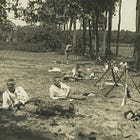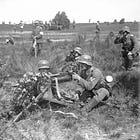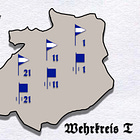Ernst Jünger on the Infantry Training Manual of 1922 (Part I)
Ausbildungsvorschrift für die Infanterie
The following post is the first half a verbatim translation of an article, written by Ernst Jünger, that was published, under the title The Infantry Training Manual [Die Ausbildungsvorschrift für die Infanterie] in the issue of the Military Weekly [Militärwochenblatt] published on 10 August 1923.
The new Infantry Training Manual [Ausbildungsvorschrift für die Infanterie] embodies an enormous amount experience. The increase in material can be seen from the outside: the slim volume of drill regulations has given way to a little library of booklets. The tempo and working methods of a time shot through with the spirit of a technical age also show themselves.
The whole is divided into a series of realms, each of which is acquiring greater independence, and are sure to multiply. (This would already have happened had it not been for the restrictions imposed by the Treaty of Versailles.) We find a booklet for the machine gun company and one for the mortar company. This is merely a matter of organization. Infantry guns and tanks integrated into infantry units will soon demand equal treatment.
We only want to relate this question, which has a deeper meaning, to the regulations. Although we don’t want to admit it, it concerns nothing less than the break up of the infantry [into separate specialities], an outcome we cannot avoid.
It cannot be denied: the infantry regiment, which before the war was a uniformly forged weapon, the smallest part of which, the individual soldier provided both fire power and shock power, has become a complicated and tangled unit. Its firepower is already largely provided by machines: the regulation calls the heavy machine gun "the most powerful infantry firearm." The fact that our machines lack shock effect is due entirely to the treaty restrictions. (In this respect, soldiers in other countries are well ahead of us.)
This said, when all we have to work with is human strength, the muscular coordination required to punch, bayonet, or throw a grenade at an enemy also resembles the working of a machine.
The attack, and not only the attack from positional warfare, is a work of interworking levers, shafts, and gears. Wherever and however the attack develops, all of its elements seek to create an integrated whole.
Technique is the interaction of fire and movement, like the combination of explosion and expansion inside an engine. Technique is an assault against an enemy regiment or machine gun nest. Technique itself the action of a raiding party [Stoßtrupp], in which everyone plays his well-defined role.
Technical developments also play a role in the Infantry Training Manual. Thus, in addition to dealing with tactics and matters peculiar to the infantry, it includes a number of specialized booklets that offer nothing of immediate interest to most members of an infantry regiment.
The growth of technology expands specialization, leading to disagreements about specialization, the excesses of which can be summed up in the expression “realm of the specialists” [Spezialistentum.] It is the battle of the old infantry against the new, the outcome of which is easy to predict.
What demands must one make of a training manual for an infantry which is still in the process of constant development and the composition of which might change abruptly in an emergency? Such a manual must contain all that is necessary for organization we have at the present. At the same time, its framework must be broad enough to enable expansion.
These requirements are fulfilled in the Infantry Training Manual. In Booklets II and V, we find a comprehensive description of battle and its participants, from the individual soldier up to the regiment.1 Each of these parts paints a picture in which the element in question plays the central role, from it own abilities and peculiarities to its relationships with surrounding units.
Thus the individual begins with the formal exercises that make him a soldier who is in control of his body and his weapon, and who is able to obey a given command in regulation fashion. Then he imagines himself on the battlefield, where he is shown how he is to act with respect to the actions of his own side and those of the enemy. Nearby, he sees his neighbors, who support him in battle and whom he has been ordered to support. A light machine gun pops up, a shell from our own artillery strikes his objective, a tree is torn to splinters, a message that needs to be forwarded arrives - in short, the technology of battle has drawn him into its machinery, and, in every moment, presents him with a fresh decision to make.
The second half of this translation can be found at the following link.
For Further Reading:
Booklet II [Heft II: Einzelausbildung] dealt with the training of the individual soldier, Booklet V [Heft V: Das Infanteriebataillon] with the infantry battalion. (For a list of the component booklets of the Infantry Training Manual of 1922, see the entry for the work in the German National Library.









